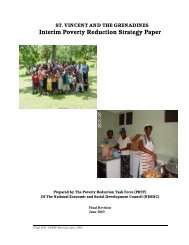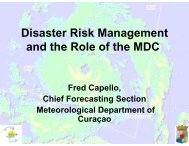The Anatomy of A Silent Crisis The Anatomy of A Silent Crisis
The Anatomy of A Silent Crisis The Anatomy of A Silent Crisis
The Anatomy of A Silent Crisis The Anatomy of A Silent Crisis
- TAGS
- anatomy
- www.bb.undp.org
You also want an ePaper? Increase the reach of your titles
YUMPU automatically turns print PDFs into web optimized ePapers that Google loves.
60 Forum 2009: Climate Change – <strong>The</strong> <strong>Anatomy</strong> <strong>of</strong> a <strong>Silent</strong> <strong>Crisis</strong><br />
Figure 10 — Physical and socio-economic vulnerability to climate change<br />
Source: Maplecr<strong>of</strong>t climate vulnerability indices; Dalberg analysis<br />
Adaptation can reduce overall vulnerability, in particular among the world’s poorest. This can be<br />
through policies <strong>of</strong> investing in early warning and evacuation systems to prepare people for storms,<br />
or assisting farmers to modify the crops grown and the timing <strong>of</strong> planting and harvesting. <strong>The</strong> good<br />
news is that there are some success stories <strong>of</strong> poor countries reducing vulnerability to the impacts <strong>of</strong><br />
climate change. Bangladesh, one <strong>of</strong> the countries most naturally vulnerable to climate change, has<br />
taken steps over the past few years to become better prepared, and thus, less vulnerable. <strong>The</strong>se<br />
steps helped reduce mortality in Bangladesh during Cyclone Sidr in 2007 which killed approximately<br />
forty times fewer people than a similar scale cyclone in 1991 (3,400 deaths versus 138,000) and that<br />
is despite the subsequent population increases over the intervening period.<br />
Poor countries suffer the vast majority <strong>of</strong> human impact <strong>of</strong> climate change<br />
To illustrate how unevenly the human impact <strong>of</strong> climate change is distributed, figure 11 shows some<br />
basic statistics on the burden <strong>of</strong> disasters. 98 percent <strong>of</strong> those affected in disasters between 2000 and<br />
2004 and 99 percent <strong>of</strong> disaster casualties in 2008 were in developing countries. 36,188 Unequal access<br />
to property insurance is another example <strong>of</strong> how people with low incomes are more exposed to the<br />
impacts <strong>of</strong> climate change. Less than 3 percent <strong>of</strong> the insured property losses189 from disasters are in<br />
low and lower middle income countries. Low-income households consider their biggest risk to be the<br />
incapacitation <strong>of</strong> the main breadwinner190 which means that a disaster constitutes one <strong>of</strong> the greatest<br />
risks they encounter.







